Pedagogical Council "Features of modern forms, methods and technologies of work in preschool educational institutions for the development of speech of preschoolers" - presentation
Relevance of the problem of speech development The problem of speech development of preschool children is very relevant today, because the percentage of preschoolers with various speech disorders remains consistently high. Mastering the native language is one of the important acquisitions of a child in preschool childhood. In modern preschool education, speech is considered as one of the foundations of the upbringing and teaching of children. Speech is a tool for the development of the higher departments of the psyche. The development of speech is associated with the formation of both the personality as a whole and in all basic mental processes. Teaching preschoolers their native language should become one of the main tasks in preparing children for school. The main task of the development of coherent speech of a child in preschool age is to improve monologue speech. All of the above types of speech activity are relevant when working on the development of coherent speech in children.
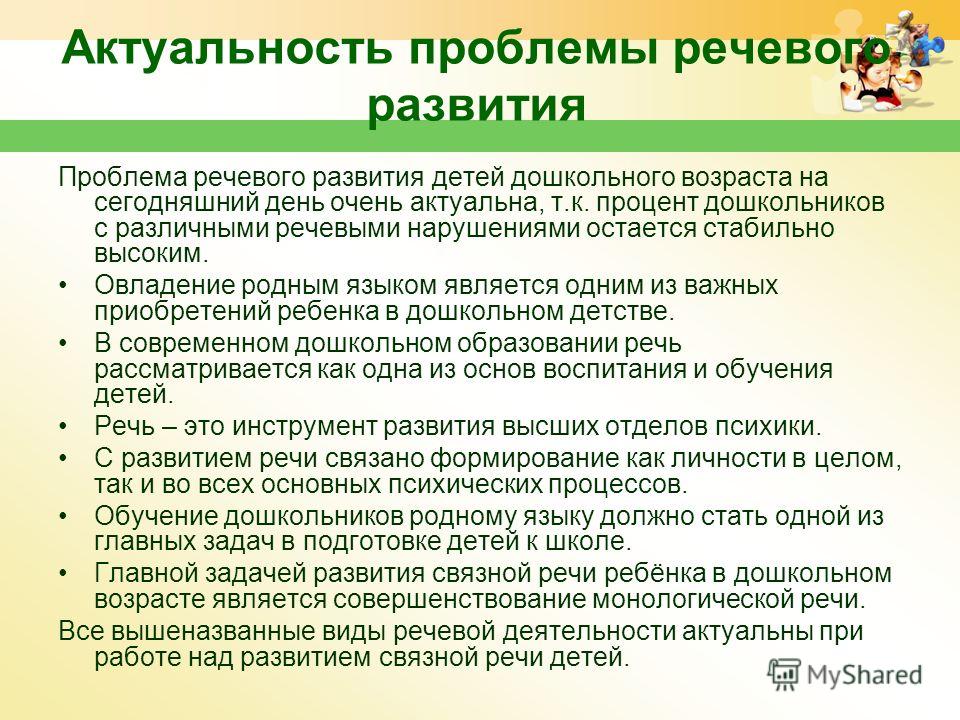
Conditions for successful speech development. 1. Creation of conditions for the development of children's speech in communication with adults and peers. 2. The teacher's possession of the correct literary speech. 3. Ensuring the development of sound culture of speech on the part of children in accordance with their age characteristics. 4. Provide children with conditions for enriching their vocabulary, taking into account age characteristics. 5. Creation of conditions for mastering the grammatical structure of speech by children. 6. Development of coherent speech in children, taking into account their age characteristics. 7. Development of children's understanding of speech, training children in the implementation of verbal instructions. 8. Creation of conditions for the development of the planning and regulating functions of the speech of children in accordance with their age characteristics. 9. Introducing children to the culture of reading fiction. 10. Encouragement of children's word-creation.
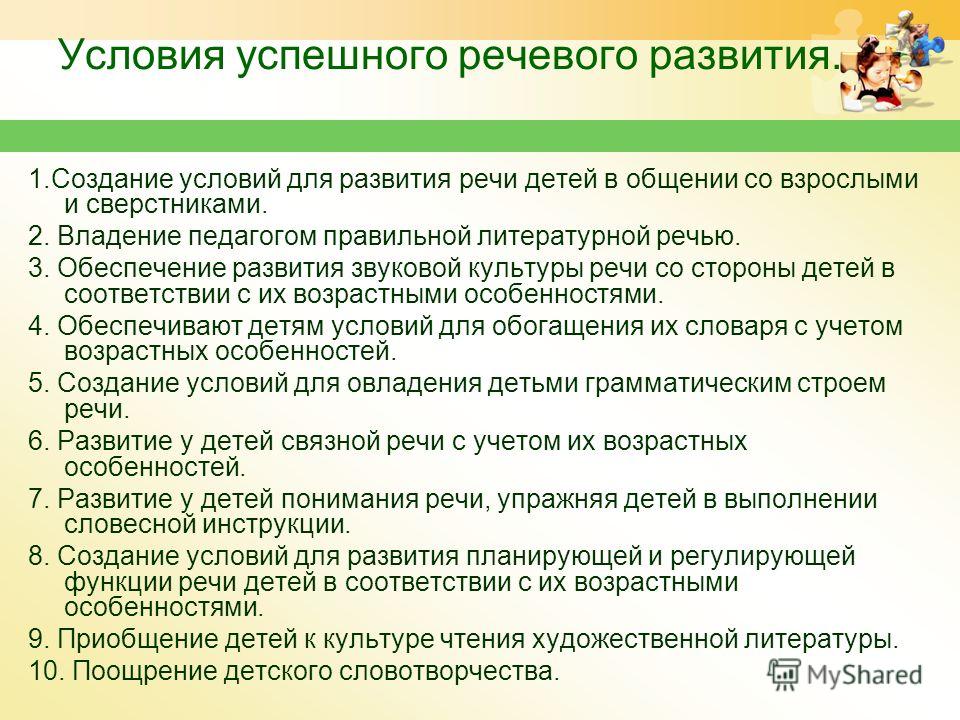
Technology of activating communication by A.G. Arushanov "The old man - the forest man"
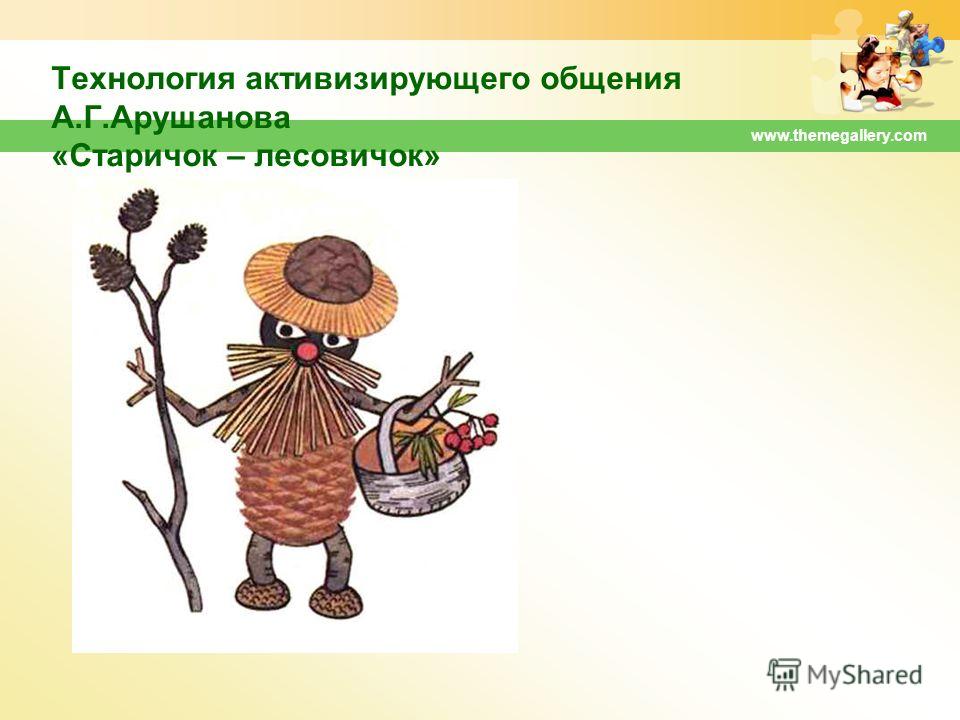

Mnemonics in preschool pedagogy are called differently Mnemonics Sensory-graphic scheme (Vorobyova V.K.) Block-square (Glukhov V.P.) Subject-schematic model (Tkachenko T.A.) Scheme of composing a Story (Efimenkova L.N. ) Collage (Bolsheva T.V.)
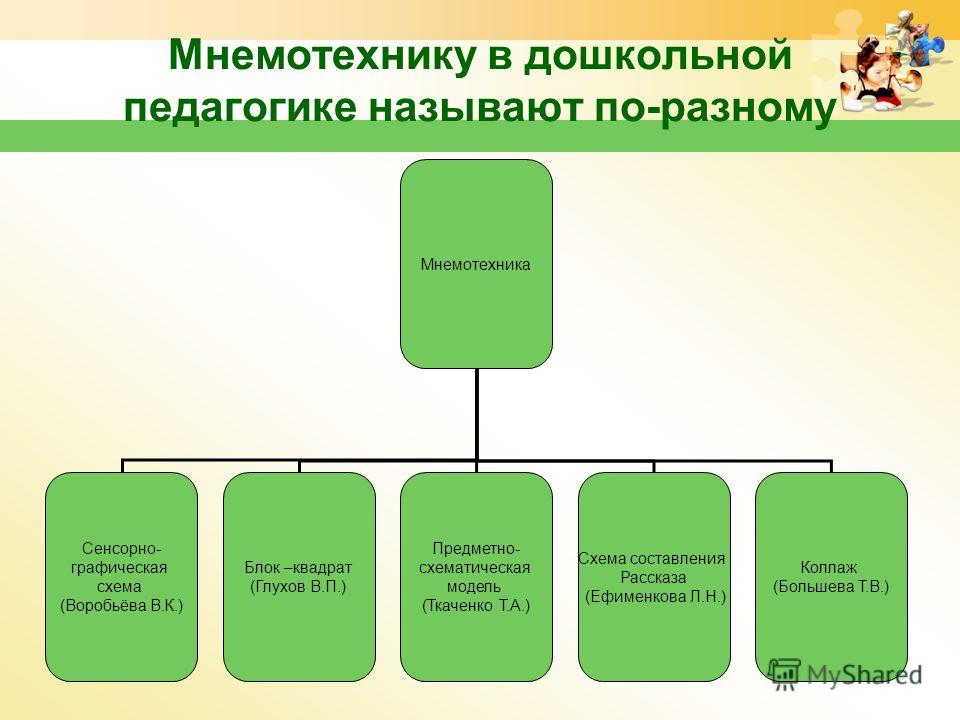
Mnemonics (Greek) - "the art of memorization" is a system of methods and techniques that ensure successful memorization, preservation and reproduction of information. The use of mnemonics in teaching preschoolers allows you to solve such problems as: 1. Development of coherent speech; 2. Converting abstract symbols into images (recoding information); 3. Development of fine motor skills of hands; 4. Development of basic mental processes - memory, attention, figurative thinking; helps to master the techniques of working with mnemonic tables and reduces training time.

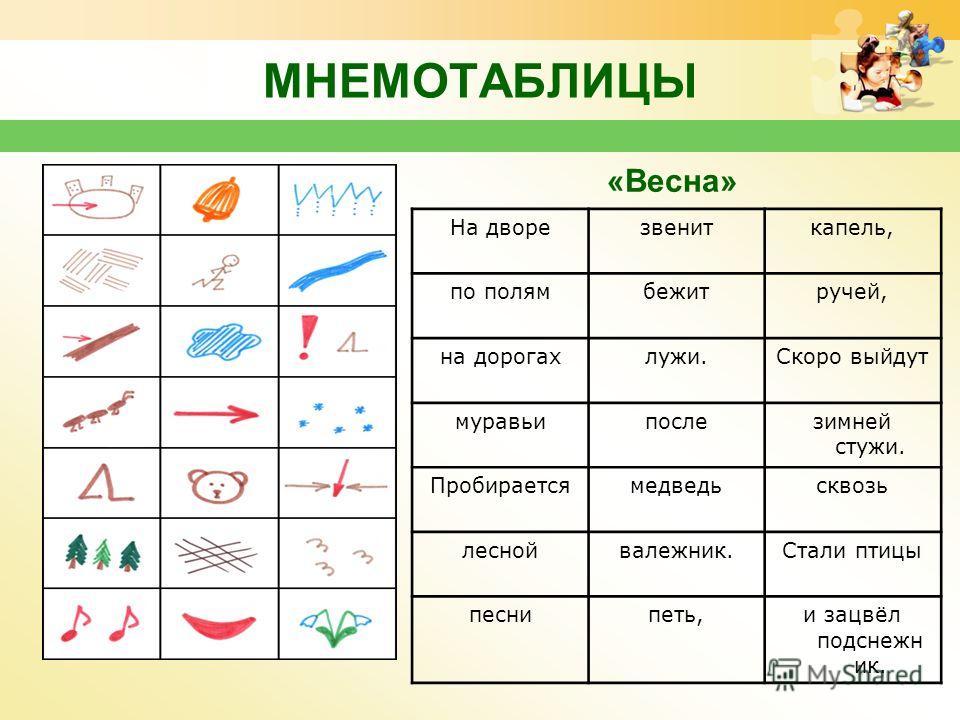

Methodology for the development of coherent speech V.K. Sparrow (cartographic scheme) The auditory, visual, associative memory is used. Objects are selected from the text, they become the reference points of the story. A subject-graphic diagram or plan is drawn up. Arrows indicate actions. The retelling is based on this subject-graphic plan. To enrich the retelling with signs, new designations are introduced into the plan: noun - adverb -
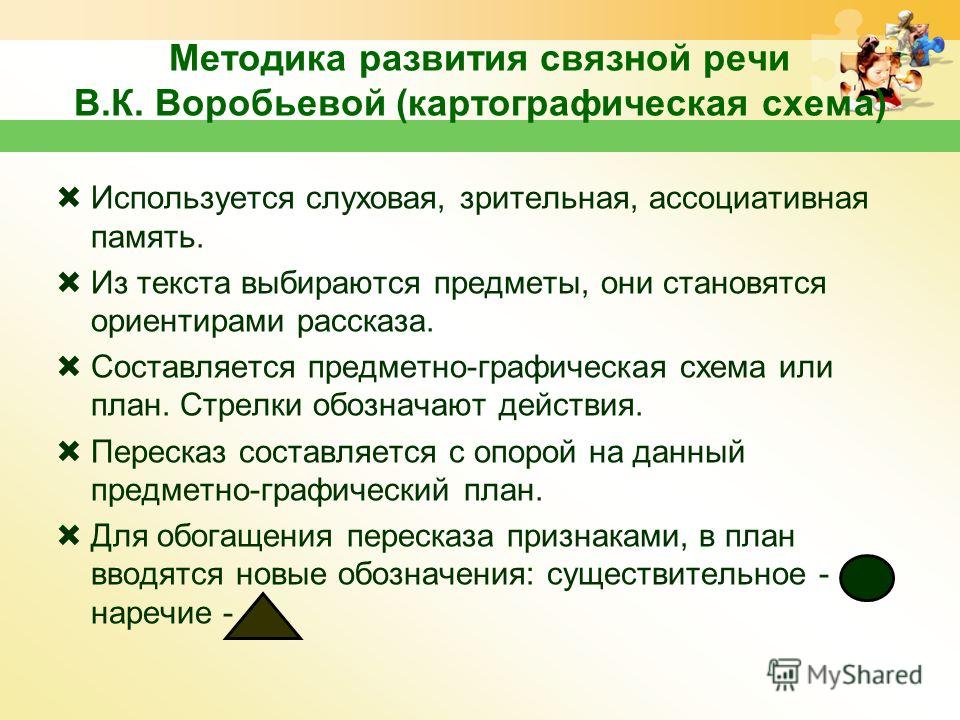
The story "Winter" (according to the method of V. K. Vorobieva)

Subject-schematic models T.A. Tkachenko Scheme of description and comparison of dishes
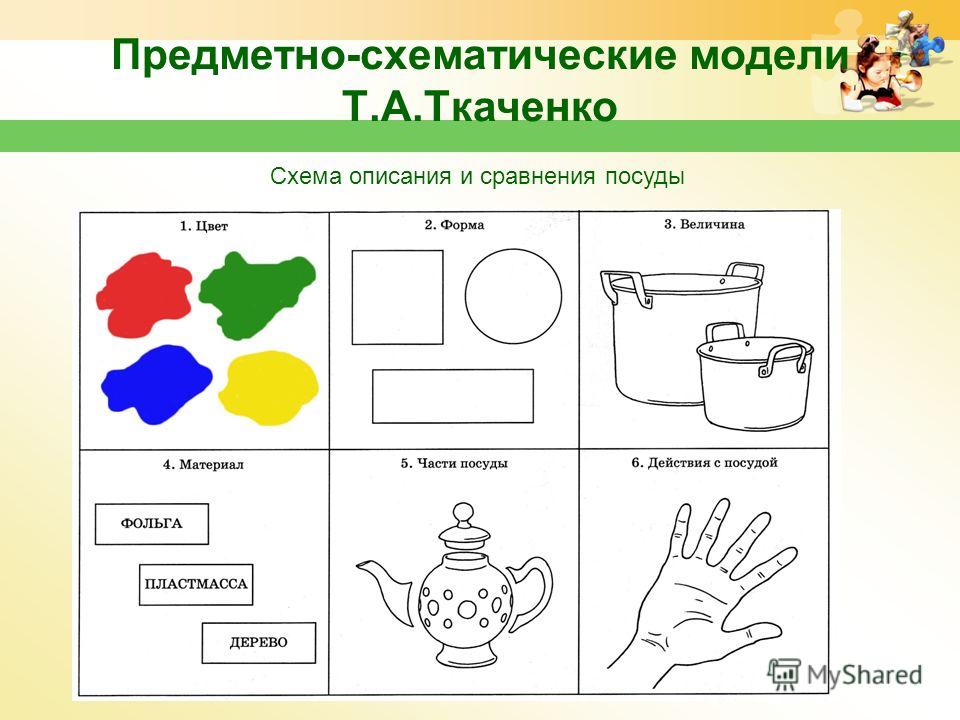
Collage technique T.V. Bolsheva
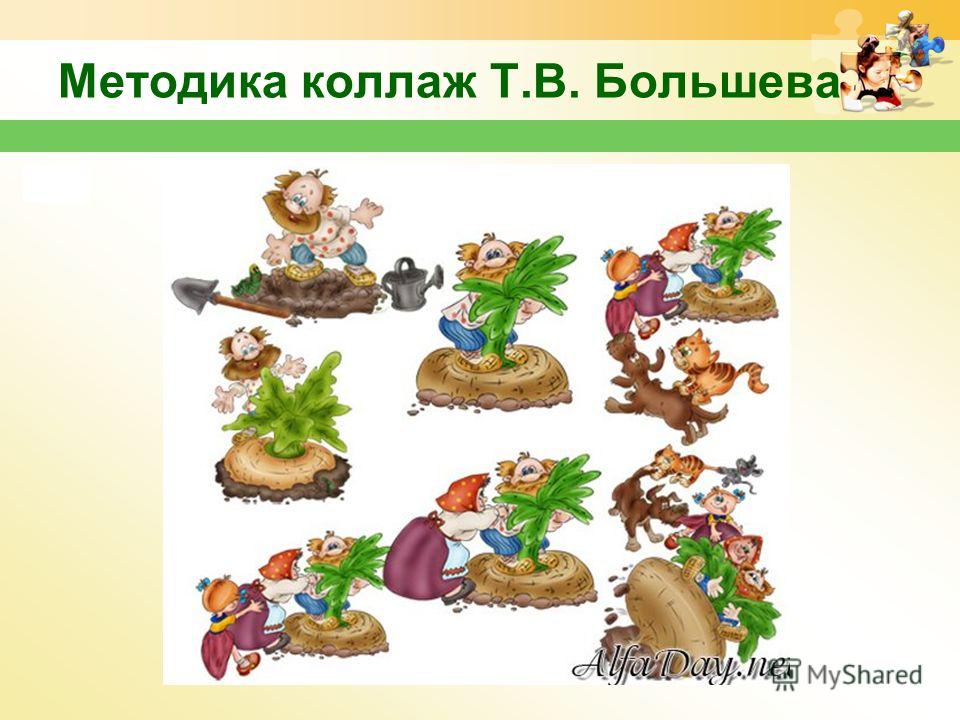
"Chatterbox" Mnemonics Enrichment of vocabulary Learning to compose stories Retelling fiction Guessing and guessing riddles
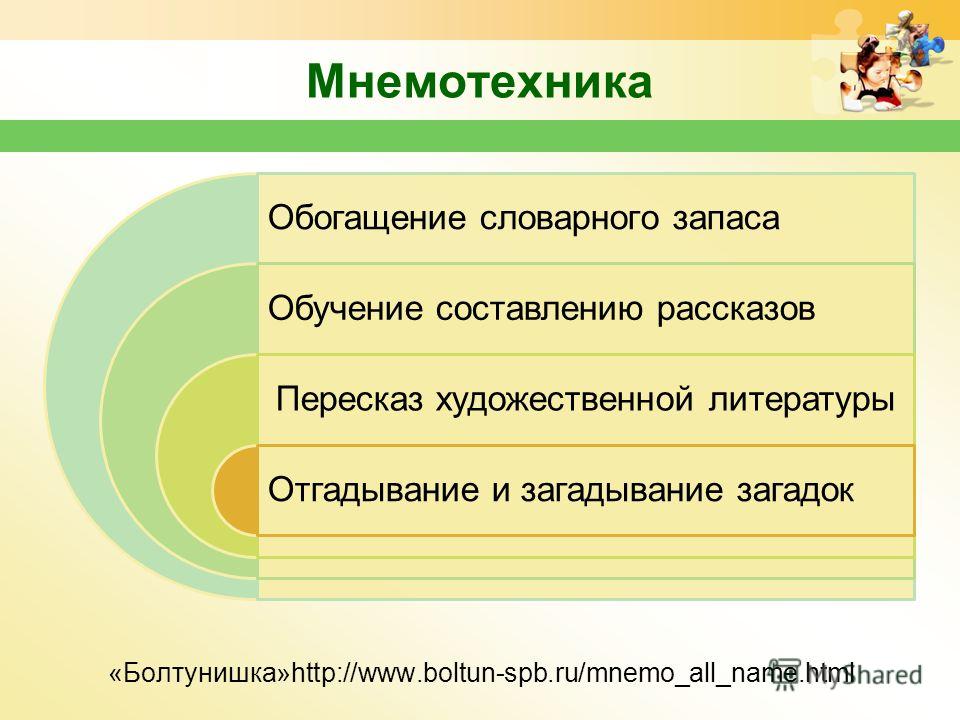
Practical part Task: a game test to determine the knowledge, skills and abilities of educators What are the forms of speech. What skills are developed in dialogue. What forms of work are used when teaching children coherent speech. What is the structure of the storytelling? A conversation between two or more people on a topic related to a situation. Speech of one interlocutor, addressed to the audience. The story is a plot that unfolds in time. What age group does the work on teaching children of monologue speech begin with? Leading technique for enhancing speech and thinking.
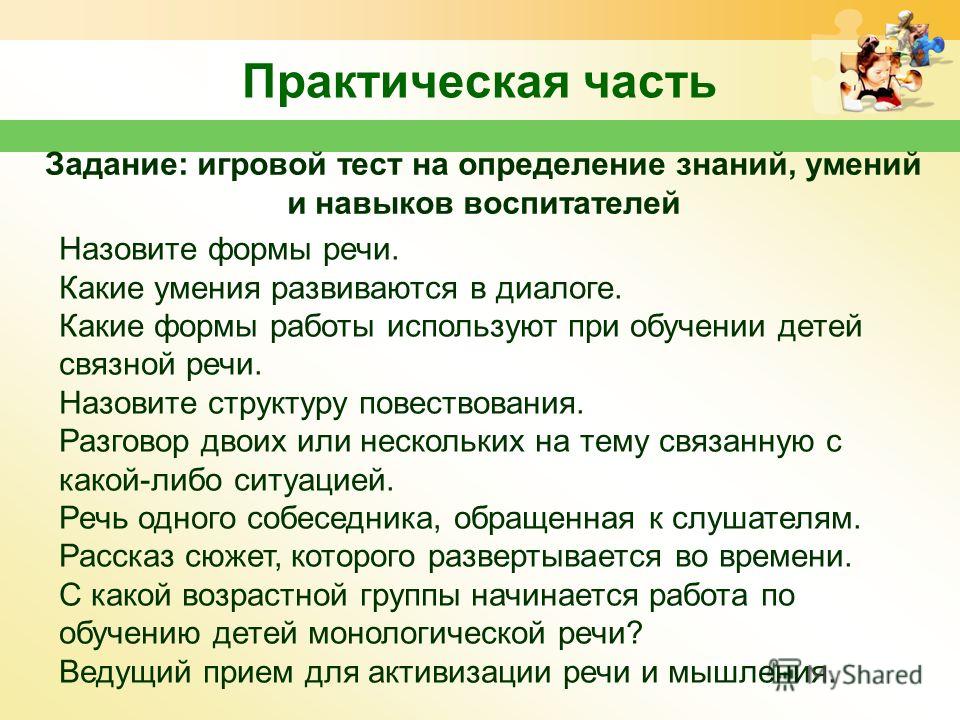
Assignment: Translate the proverbs into Russian The son of a leopard is also a leopard. (Africa) The apple falls not far from the apple tree. You can't hide a camel under a bridge. (Afghanistan) You can't hide an awl in a sack. Be afraid of a quiet river, not a noisy one. (Greece) There are devils in the still waters. Silent Mouth - Golden Mouth (Germany) Words are silver and silence is gold. He who asks will not get lost. (Finland) He will bring the language to Kiev.
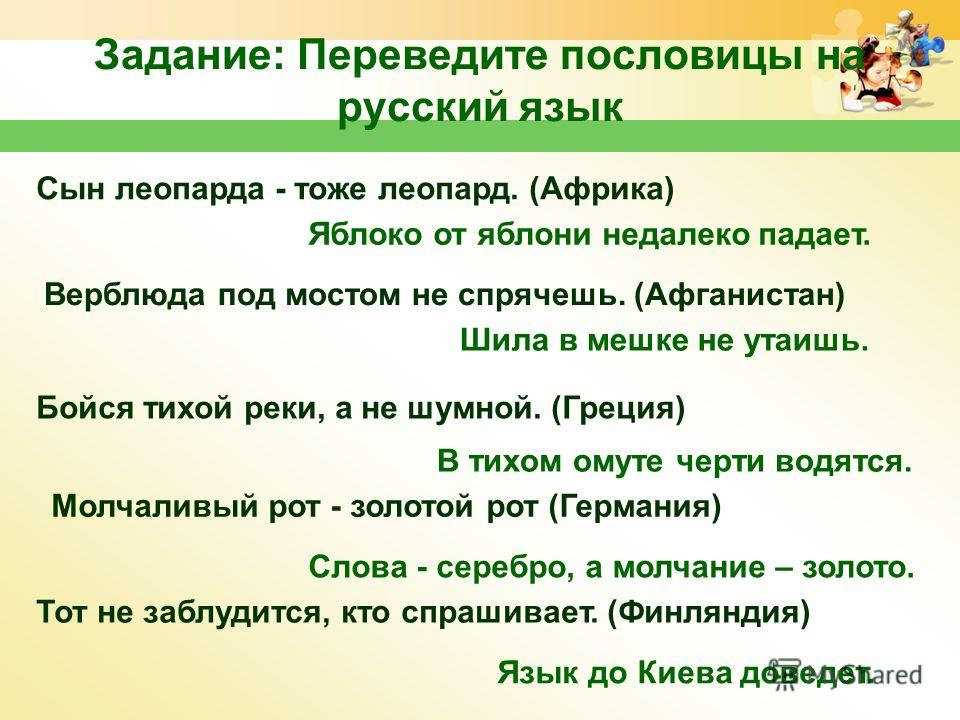
Assignment: Explain expressions The thing is in the hat Everything is in order Dancing to someone else's tune Acting not on their own As on pins and needles A state of extreme excitement, anxiety Scratching your tongue Chatting in vain Fool your head Distract from the main business with empty conversations
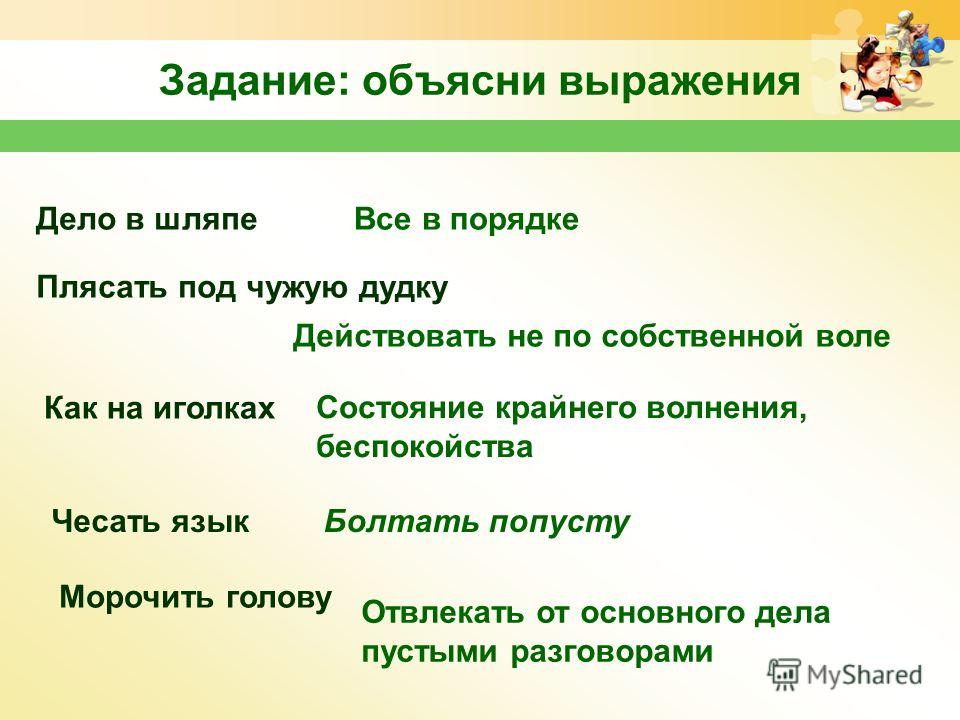
Assignment: name the proverb completely (according to 2 given words) Family - soul The whole family is together, and the soul is in place. Home - Walls In your home and walls help. With a feather - learning Red is a bird with a feather, and a man is learning. Feeds - spoils Labor feeds, and laziness spoils. Time - an hour Business time, fun - an hour. Warmth is good When the sun is warm, when the mother is good.
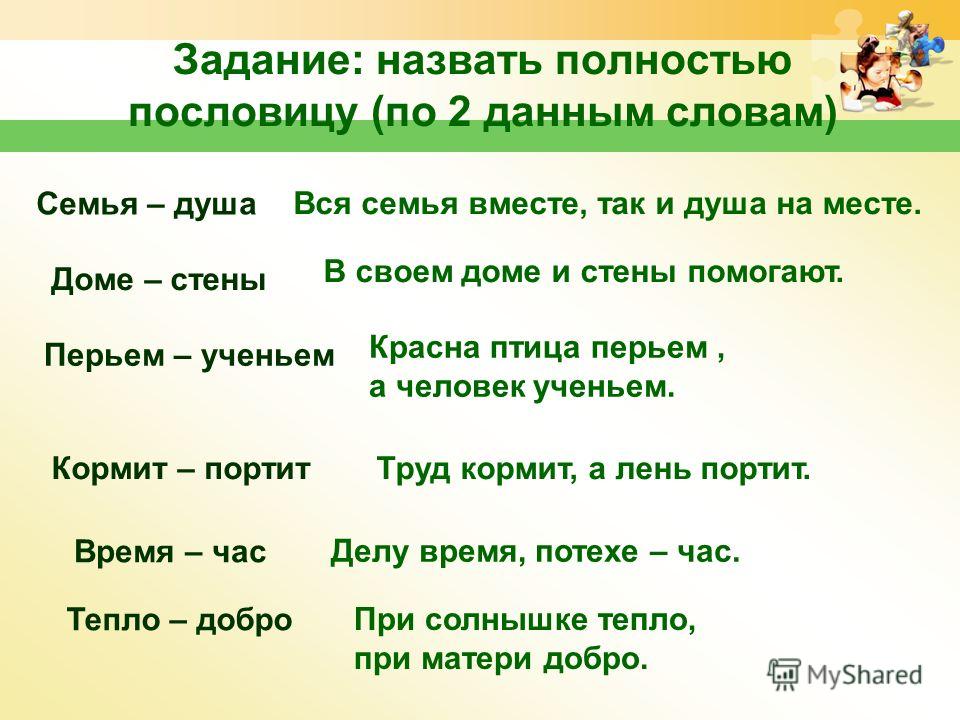
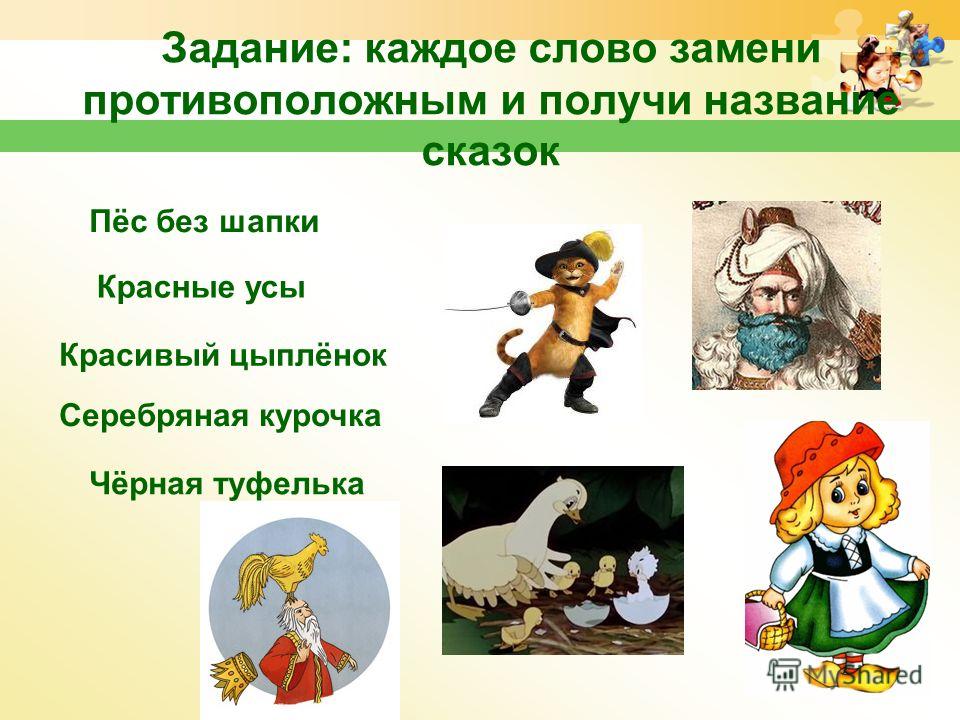
Sinkwine The first line is the theme of syncwine, it contains one word (usually a noun or pronoun), which denotes an object or thing that will be discussed. Noun Pronoun The second line is two words (most often adjectives or participles), they describe the signs and properties of the selected in the syncwine of an object or object. adjectives of participles The third line is formed by three verbs or gerunds, describing the characteristic actions of the object. verbs of adverbial participles The fourth line is a four-word phrase expressing the personal attitude of the author of the syncwine to the described object or object. The fifth line is one resume word that characterizes the essence of the subject or object. Summary Strict adherence to the rules for writing syncwine is not necessary. For example, you can use three or five words to improve text on the fourth line, and two words on the fifth line. Use cases for other parts of speech are also possible.
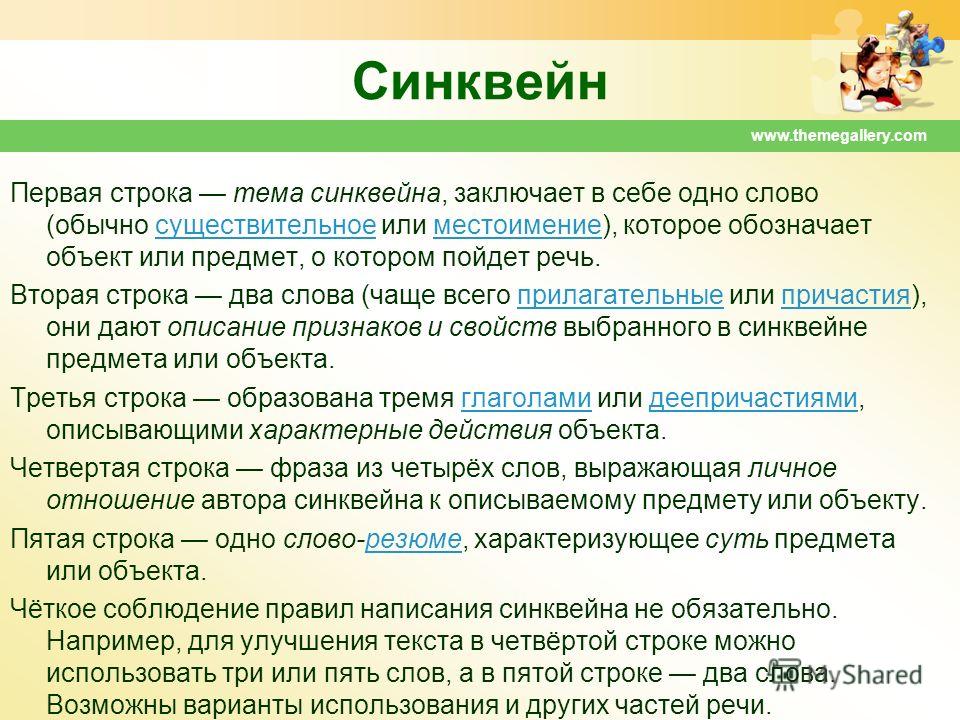
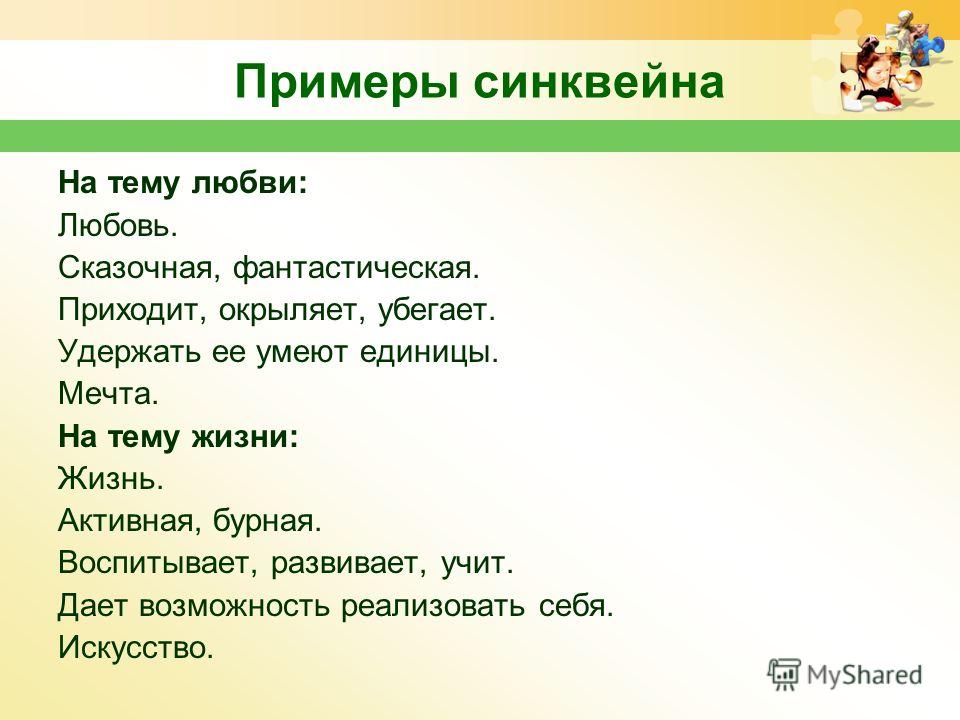
Make a syncwine on the topic family What is it? (beautiful, strong, friendly, funny, big) What is she doing? (proud, caring, helping, loving, hoping ...) Family proposal, aphorism or proverb. (The whole family is together and the soul is in place. The family agrees, this is how things are going very well. I love my family.) Synonym, or, as another name for the family (My home! Beloved. Native).
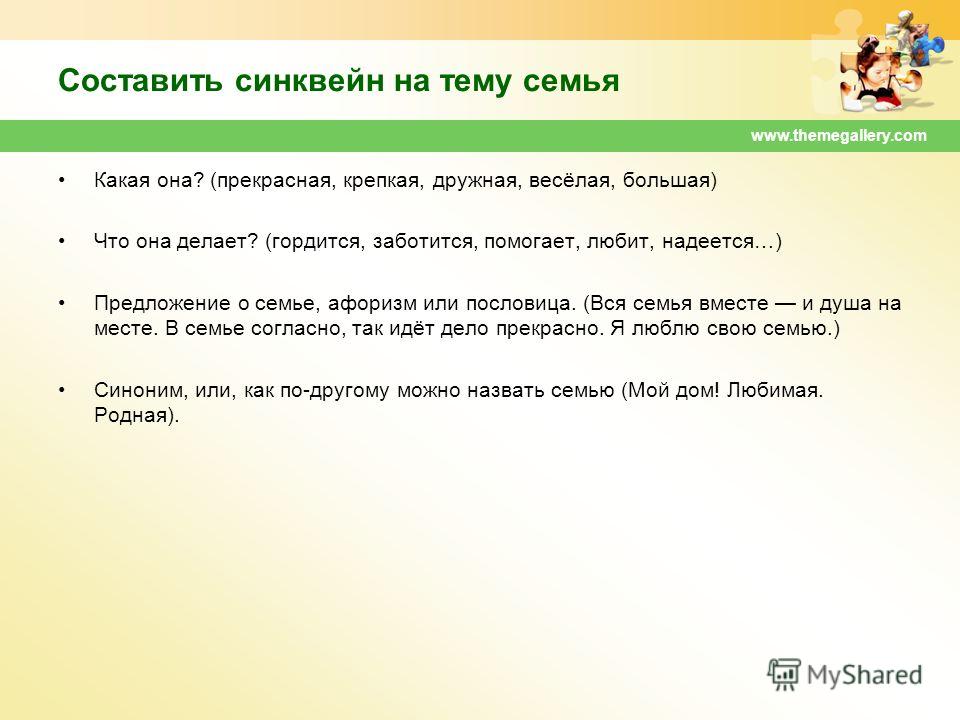
Sinkwine The first line is the theme of syncwine, it contains one word (usually a noun or pronoun), which denotes an object or thing that will be discussed. Noun Pronoun The second line is two words (most often adjectives or participles), they describe the signs and properties of the selected in syncwine of an object or object. adjectives of participles The third line is formed by three verbs or gerunds, describing the characteristic actions of the object. verbs of adverbs. The fourth line is a four-word phrase expressing the personal attitude of the author of the syncwine to the described object or object. The fifth line is one resume word that characterizes the essence of the subject or object. Summary Strict adherence to the rules for writing syncwine is not necessary. For example, you can use three or five words to improve text on the fourth line, and two words on the fifth line. Use cases for other parts of speech are also possible. Rules for courageous and persistent teachers If you are having difficulty in working on the development of speech, then plan this type of activity not sometimes, not often, but very often. It will get easier in 5 years. Never answer your own question yourself. Be patient, and you will wait for your children to respond to it. You can only help with one more question, or two, or ten ... But know: the number of questions is inversely proportional to the level of skill. Never ask a question that can be answered yes or no. It does not make sense. After the lesson, review the outline again, recall all the questions you asked the children, and replace it with one more accurate one. If the story did not work out or worked out with difficulty - smile, because this is great, because success is ahead.
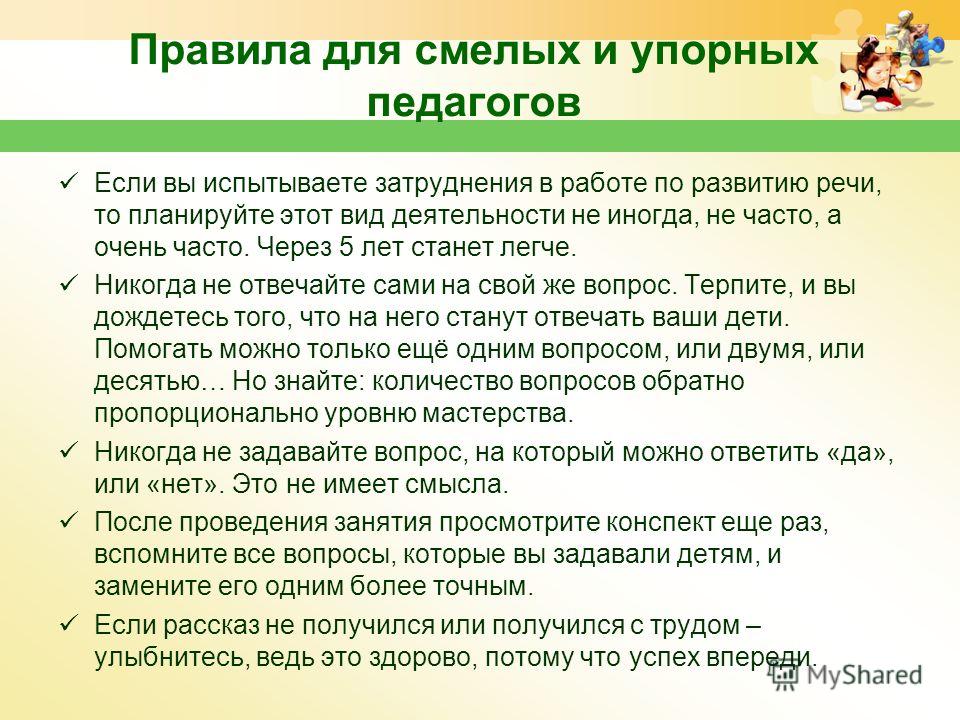
The decision of the pedagogical council 1. To continue to create conditions at the preschool educational institution for the development of children's speech: - to replenish the groups with didactic games for the development of speech (responsible group educators, period from March 31)) - to arrange stands for parents "Development of coherent speech of a preschooler" (responsible group teachers for a period - from to Reflect in the calendar plans individual work on the development of coherent speech of children. (responsible senior educator Portnova T.A., monthly analysis of calendar plans) 3. To increase the level of development of coherent speech, use effective forms of work. (responsible head of the school, senior educator - visiting GCD in groups) 4. Conduct parent meetings in groups on the topic "Development of preschooler's speech" 5. Include in the self-education plan acquaintance with innovative technologies for the development of speech of preschoolers. (before March 20)

